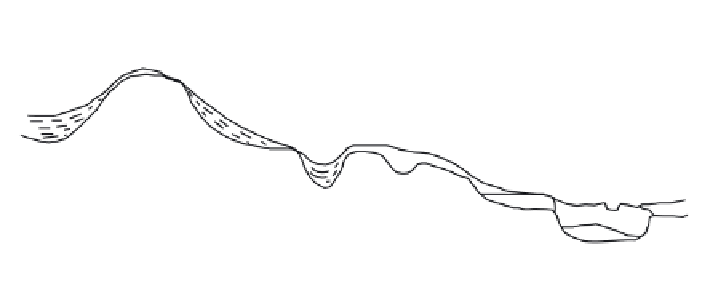Geoscience Reference
In-Depth Information
Primary
erosion
Slope processes
creep, landsliding,
slope, wash, etc.
Episodic
erosion
Loessic input
Colluvial storage
Within channel
storage
10
2
-10
3
Stream
erosion
1-10
2
Deeper lowland
soils erosion
Alluvial
storage
Colluvial
storage
Dry valley
fill
10
2
-10
3
10
3
10
3
Hard rocks
Lake
infilling
Infilled
palaeolake
Fig. 3.8
Duration
(in years) and location of
long-term sediment storage
in a typical humid, cool river
basin. (After Brown 1997.)
10
3
-10
4
10
3
-10
4
Soft rocks
Erosion and
remobilization
Increasing sediment in storage
Water
discharge
Fig. 3.9
Definition of equilibrium and
disequilibrum in stream geometry. Channel width
varies congruently with water discharge (i.e.
equilibrium) until extreme discharge causes bank
erosion and channel widening. Subsequently, the
channel is in disequilibrium with water discharge
and requires a certain lag time to regain, by
deposition, equilibrium. (After Bridge 2003.)
Channel
width
Equilibrium
Disequilibrium
Equilbrium
Time
causes disequilibrium between channel width and
discharge. There is a lag time before the system
readjusts to an equilibrium state once again.
Other authors have described
activation thres-
holds
for sediment transfer. In these situations,
some sort of barrier must be overcome before
sediment transport can occur. Rowan et al. (2000)
described two large flood events that caused
considerable sediment transfer in the river basin
of Wyresdale Park Lake in north-west England.
They argued that the activation threshold to
this transfer was the accumulation of sediment
within colluvial footslopes during a dry period
immediately preceding the flooding. Once these
threshold-crossing events occur, a river channel
responds, often rapidly and dramatically, and a
new set of conditions (changes in gradient, cross-
sectional and planform geometry) develops.
The remainder of this chapter considers many
examples of responses to river sedimentation to
such threshold-crossing events and their under-
lying environmental causes.
3.3
PROCESSES AND IMPACTS OF NATURAL
DISTURBANCE EVENTS
Fluvial environments are subject to fluctuations
in rates of sediment transport and accumulation
that are caused by natural disturbance events
including climate change, tectonic uplift, glacio-
isostatic rebound, forest fires and volcanic erup-
tions. This section presents an overview of the
effects of these processes on sedimentation in
fluvial environments.
3.3.1 Climate change
Climate change can be defined principally as
modifications in precipitation and temperature
(and related features such as permafrost cover),
and some authors also include modifications
to vegetation cover in the definition (Knighton
1998). Climate change can occur on a wide range
of time-scales: from 10
3
to 10
5
years (major
glaciations), to 10
3
to 10
2
years (interglacial or















